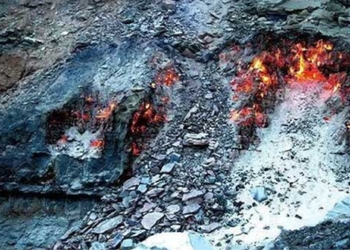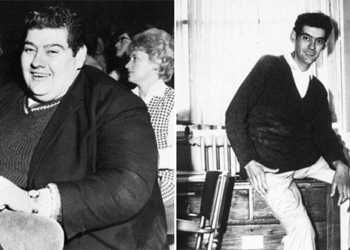These incidents have led to significant technological advancements that ensure our safety in air travel today.
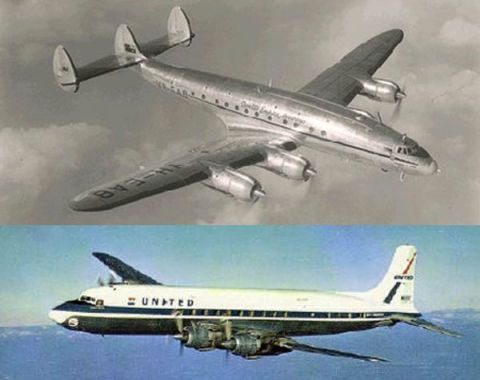
Two Douglas DC-7 aircraft and a Lockheed L-1049 Super Constellation before their mid-air collision in 1956. (Photo: Popularmechanics.com).
Today, flying on a jet is extremely safe. However, the reliability of air travel has improved significantly due to past incidents, which led to crucial advancements in flight safety. From mid-air collisions to in-flight fires, these events have spurred major technological progress that has made flying a safer mode of transportation. Below are some incidents that resulted in breakthroughs, helping maintain the practice of air travel.
Avoiding Collisions and Improved Air Traffic Control
On June 30, 1956, in the skies over the Grand Canyon in Arizona, two planes that had just taken off from Los Angeles International Airport—a Douglas DC-7 from United Airlines bound for Chicago and a Lockheed L-1049 Super Constellation from Trans World Airlines heading to Kansas City—collided in mid-air. All 128 passengers and crew members on both flights perished.
The accident prompted a $250 million upgrade to the air traffic control (ATC) system, a significant amount at the time. It also led to the establishment of the Federal Aviation Administration (FAA) in 1958 to oversee aviation safety.
Subsequent improvements were made after a small private aircraft entered the Los Angeles terminal control area on August 31, 1986, colliding with an Aeromexico DC-9 and resulting in 86 fatalities. The FAA subsequently mandated that small aircraft entering controlled airspace must use transponders or electronic devices to communicate their position and altitude to operators and air traffic control.
Additionally, passenger aircraft were required to be equipped with a TCAS II collision avoidance system, which helps detect potential collisions with other aircraft. Since then, no small planes have collided with commercial aircraft in the U.S.
Teamwork in the Cockpit
On December 28, 1978, a DC-8 operating as United Flight 173, scheduled from John F. Kennedy International Airport in New York City to Portland International Airport in Portland, Oregon, had to circle near the airport for an hour as the crew attempted to address a landing gear issue. Although the flight engineer warned that fuel supply was dwindling, the captain took too long to make a final decision. As a result, the aircraft ran out of fuel and crashed in the suburbs of Portland, killing 10 people onboard.
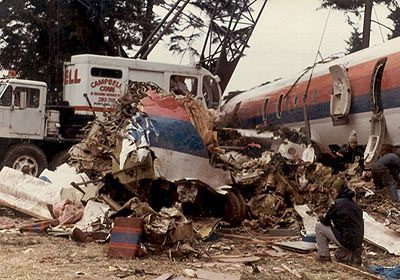
The DC-8 of United Flight 173 after crashing in the suburbs of Portland. (Photo: pinterest.co.uk).
The National Transportation Safety Board (NTSB) deemed this accident a classic example of a recurring issue: cockpit management and teamwork during a situation involving aircraft system malfunctions. They concluded that the flight crew was not aware of the remaining fuel because their attention was almost entirely focused on the landing gear problem.
The NTSB also identified the cause of the incident: the captain did not accurately monitor the aircraft’s fuel status or respond appropriately to the low fuel condition and the crew’s concerns about the fuel situation. This led to the depletion of fuel in all engines. This oversight was attributed to being overly focused on the landing gear issue and preparing for a potential emergency during landing. Meanwhile, the other two crew members did not fully recognize the importance of the fuel status or communicate their concerns effectively to the captain.
To address the issue, the NTSB recommended improvements in cockpit training procedures based on a new concept of Crew Resource Management (CRM). This new training approach addresses behavioral management challenges such as poor crew coordination, loss of situational awareness, and common judgment errors seen in aviation accidents. The incident is recognized as the catalyst for the revolution in crew management in aviation, moving away from the traditional airline hierarchy of “the captain is above all”, with CRM emphasizing teamwork and communication among crew members, which has now become the industry standard.
United Airlines established the first CRM program for pilots in the industry in 1981. This program is now utilized worldwide, leading some to regard the United 173 incident as one of the most significant accidents in aviation history. Captain Al Haynes of United Airlines, who heroically landed a DC-10 facing severe issues in Sioux City, Iowa in 1989, stated: “Without [CRM training], we certainly wouldn’t have been able to do it.”
Smoke Detection
On June 2, 1983, Air Canada Flight 797, a DC-9 flying at an altitude of 10 km from Dallas to Toronto, began to emit smoke from the rear lavatory. Thick black smoke soon filled the cabin, forcing the aircraft to make an emergency descent. The pilots could barely see the control panel due to the smoke, but managed to land in Cincinnati. However, upon opening the doors and emergency exits, the cabin erupted into flames before anyone could escape. Of the 46 people on board, 23 lost their lives.
The FAA subsequently mandated that aircraft lavatories be equipped with smoke detectors and automatic fire extinguishers. Within five years, all jet aircraft were fitted with additional fire-resistant layers on seat cushions and floor lighting systems to guide passengers to exits in case of thick smoke. Aircraft manufactured after 1988 featured improved flame-resistant materials.
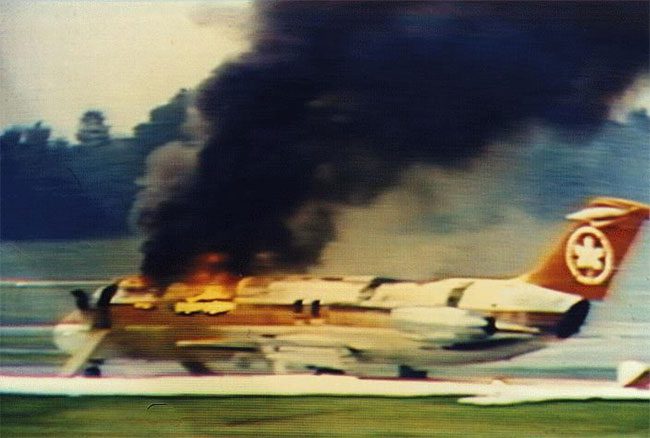
Fire and smoke rising from Air Canada Flight 797’s DC-9. (Photo: Source: pinterest.co.uk).
Fire Prevention in Cargo Holds
Although the FAA implemented fire prevention measures in the cabin following the 1983 Air Canada accident, they did not take actions to protect the cargo holds of passenger aircraft, despite warnings from the NTSB after a cargo hold fire incident in 1988 that safely landed. However, the tragic accident of ValuJet Flight 592 in the Everglades near Miami on May 11, 1996, compelled the agency to act.
The fire aboard ValuJet Flight 592 was caused by improperly packed oxygen generators by SabreTech, the airline’s maintenance contractor. The friction and impact caused an explosion, and the generated heat ignited the fire, which spread due to the oxygen being released. The pilots could not land the burning aircraft, resulting in the loss of 110 lives. Consequently, the FAA responded by requiring smoke detectors and automatic fire extinguishers to be installed in the cargo holds of all commercial aircraft. The incident also reinforced regulations against transporting hazardous materials on planes.
Preventing Electrical Sparks
It is every flight’s worst nightmare: an aircraft exploding mid-air without any clear reason. The explosion on July 17, 1996, on TWA Flight 800, a Boeing 747 that had just taken off from JFK bound for Paris, resulted in the deaths of all 230 people on board and sparked significant controversy.
After meticulously reconstructing the wreckage, the NTSB dismissed the possibility of a terrorist bombing or missile attack, concluding that it was likely due to an electrical short in the wiring harness, which produced sparks in the fuel sensor.
Since then, the FAA has mandated changes to reduce sparks from faulty wiring systems and other sources. Meanwhile, Boeing has developed an inerting system (reducing the potential for igniting flammable materials stored in a confined space), injecting nitrogen into fuel tanks to reduce the risk of explosions. This system has been implemented on all newly manufactured aircraft.

Debris from an Airbus A330-200 recovered from the ocean. (Photo: Popularmechanics.com).
Manual Training to Mitigate Over-Reliance on Automation
Approximately three hours into the flight from Rio to Paris on June 1, 2009, an Airbus A330-200 operating as Air France Flight 447 encountered severe thunderstorms and lost signal.
From an altitude of 11.5 km, the aircraft entered a stall before plunging into the southern Atlantic Ocean, resulting in the deaths of all 228 people on board. Days later, debris from the aircraft was discovered floating on the surface of the sea, but the whereabouts of the rest of the aircraft remained a mystery for over two years until a privately funded search located much of the fuselage, the remains of the victims, and crucial black boxes.
Investigators have partially solved the case, based on automated information sent from the disabled aircraft as it crashed, revealing that the speed tracking system had frozen and malfunctioned, causing a series of problems.
With the wreckage now discovered, evidence led experts to conclude that the accident was due to the pilot’s failure to take corrective action to recover after the aircraft ceased functioning.
These findings have shed light on flight control technology and the reliance on computers, rather than humans, to make the final decisions related to flights. Both Boeing and Airbus utilize the “Fly-by-Wire” system (a flight control system that relies entirely on electronic signals and computers), but the accident has prompted a renewed effort to retrain pilots to operate aircraft manually—regardless of what the automated systems are indicating.








































